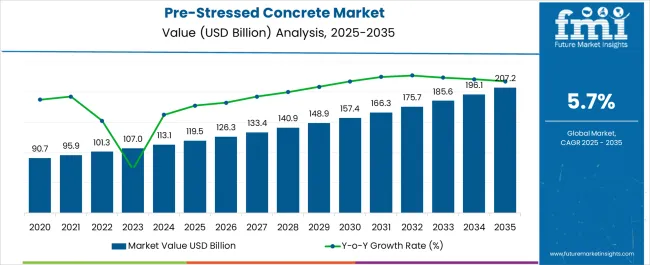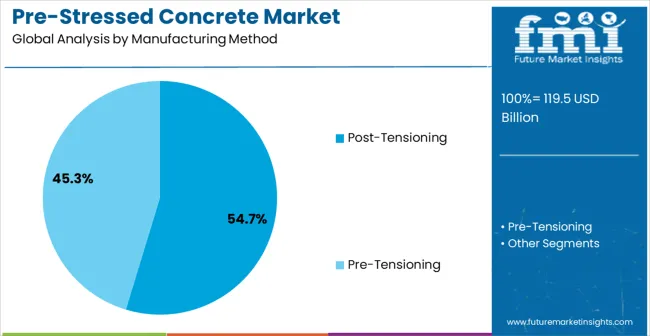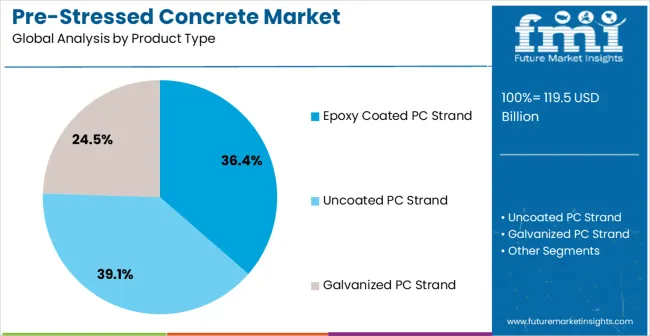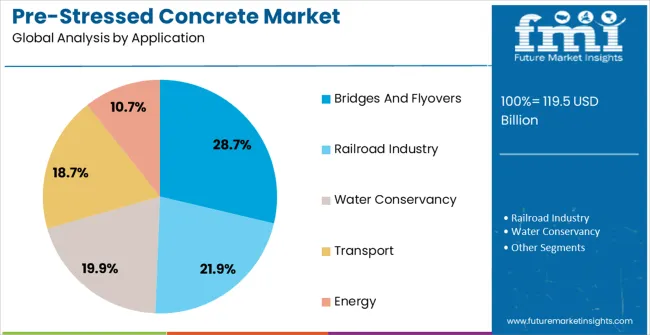The Pre-Stressed Concrete Market is estimated to be valued at USD 119.5 billion in 2025 and is projected to reach USD 207.2 billion by 2035, registering a compound annual growth rate (CAGR) of 5.7% over the forecast period.

| Metric | Value |
|---|---|
| Pre-Stressed Concrete Market Estimated Value in (2025 E) | USD 119.5 billion |
| Pre-Stressed Concrete Market Forecast Value in (2035 F) | USD 207.2 billion |
| Forecast CAGR (2025 to 2035) | 5.7% |
The Pre-Stressed Concrete market is experiencing robust growth, primarily driven by the rising demand for durable, cost-efficient, and high-performance construction materials across infrastructure and commercial projects. Urbanization and industrialization are fueling investments in roads, bridges, high-rise buildings, and metro rail systems, where pre-stressed concrete is widely applied for its superior load-bearing capacity and reduced material consumption. The increasing focus on sustainable construction practices is also supporting demand, as pre-stressed concrete structures offer longer service life and reduced maintenance compared to conventional reinforced concrete.
Government investments in smart cities, transportation networks, and public infrastructure are further accelerating adoption. Technological advancements in tensioning systems, material science, and quality control are improving efficiency and expanding applicability.
The construction industry’s shift toward faster project completion and enhanced safety is reinforcing the role of pre-stressed concrete as a preferred material As global infrastructure development continues to expand, particularly in emerging economies, the market is expected to witness strong momentum, supported by ongoing innovation, favorable policies, and rising public-private partnerships in the construction sector.
The pre-stressed concrete market is segmented by manufacturing method, product type, application, pre-stress concrete wires, and geographic regions. By manufacturing method, pre-stressed concrete market is divided into Post-Tensioning and Pre-Tensioning. In terms of product type, pre-stressed concrete market is classified into Epoxy Coated PC Strand, Uncoated PC Strand, and Galvanized PC Strand. Based on application, pre-stressed concrete market is segmented into Bridges And Flyovers, Railroad Industry, Water Conservancy, Transport, and Energy. By pre-stress concrete wires, pre-stressed concrete market is segmented into 7 Wires, 2 & 3 Wires, and 19 Wires. Regionally, the pre-stressed concrete industry is classified into North America, Latin America, Western Europe, Eastern Europe, Balkan & Baltic Countries, Russia & Belarus, Central Asia, East Asia, South Asia & Pacific, and the Middle East & Africa.

The post-tensioning manufacturing method segment is projected to hold 54.7% of the market revenue share in 2025, making it the leading technique. Its dominance is attributed to the ability to provide superior structural strength while using less material compared to traditional reinforced methods. Post-tensioning allows for longer spans and thinner slabs, enabling flexible design and reduced construction costs.
It is particularly advantageous in high-rise buildings, parking structures, and large infrastructure projects where space efficiency and load resistance are crucial. The method also enhances crack resistance and durability, extending the service life of structures while reducing maintenance needs. Widespread availability of equipment and skilled labor for post-tensioning is further encouraging adoption across both developed and developing regions.
Additionally, the ability to accommodate complex architectural designs without compromising safety is increasing its preference among contractors and engineers As infrastructure projects continue to expand globally, post-tensioning is expected to maintain its leadership, supported by cost savings, durability, and adaptability to modern construction requirements.

The epoxy coated PC strand segment is anticipated to account for 36.4% of the market revenue share in 2025, positioning it as the leading product type. This dominance is primarily driven by the growing demand for corrosion-resistant and durable construction materials. Epoxy coating provides a protective barrier that enhances the strand’s longevity, especially in environments exposed to moisture, chemicals, or extreme weather conditions.
Its use significantly reduces maintenance costs and ensures structural integrity, making it highly preferred in large infrastructure projects such as bridges, highways, and marine structures. The increasing focus on sustainable and long-lasting building solutions is further boosting adoption. Additionally, technological advancements in coating processes have improved the quality, performance, and cost efficiency of epoxy coated PC strands, reinforcing their market position.
Strong government investments in resilient infrastructure, along with the growing emphasis on safety and compliance standards, are also driving demand As the need for durable materials intensifies, epoxy coated PC strands are expected to remain a key product in the pre-stressed concrete market.

The bridges and flyovers segment is expected to hold 28.7% of the market revenue share in 2025, establishing it as the leading application area. This leadership is being reinforced by the massive global investments in transportation infrastructure aimed at reducing congestion, improving connectivity, and supporting economic growth. Pre-stressed concrete is highly favored in bridges and flyovers due to its ability to handle heavy loads, resist cracking, and provide long service life under dynamic stress conditions.
The material allows for longer spans with fewer supports, which reduces construction costs and improves design flexibility. Its proven performance in ensuring structural safety and reliability has made it the preferred choice for government-backed and large-scale projects.
Additionally, the increasing need for modernization of aging infrastructure is driving demand for pre-stressed concrete in repair and replacement initiatives As urban populations grow and transportation networks expand, the application of pre-stressed concrete in bridges and flyovers is expected to remain strong, supported by durability, cost-effectiveness, and compliance with modern engineering standards.
Pre-stressed concrete is used widely in multistoried buildings, civic infrastructure and bridges owing to the inherent weakness of concrete in tension which can be removed via the product. The use of pre-stressed concrete improves its service load factor and reduce deflection & cracking.
Furthermore, the durability of concrete is also increased due to use of reinforced polymer in pre-stressing. The expanding focus on infrastructure development has enabled the growth of many sub-sectors connected to the construction industry.
As pre-stressed concrete wire and component are a substantial part of the construction material industry, the market consumption rate will thereby witness an increase, particularly for prefab construction. This increase in demand is expected to encourage manufacturers to focus more on enlighten the quality of their product and they will significantly benefit from the subsidies delivered by the various governments than it enables them to bring together to economical product.
Due to increasing demand of railway transportation, it is expected that the railroad industry will dominate the global pre-stressed concrete market in the forecast period. Moreover, the rise in reusable income and fast growing urbanization will accelerate the growth of this market segment during the forecast period.

| Country | CAGR |
|---|---|
| China | 7.6% |
| India | 7.1% |
| Germany | 6.5% |
| Brazil | 5.9% |
| USA | 5.4% |
| UK | 4.8% |
| Japan | 4.2% |
The Pre-Stressed Concrete Market is expected to register a CAGR of 5.7% during the forecast period, exhibiting varied country level momentum. China leads with the highest CAGR of 7.6%, followed by India at 7.1%. Developed markets such as Germany, France, and the UK continue to expand steadily, while the USA is likely to grow at consistent rates. Japan posts the lowest CAGR at 4.2%, yet still underscores a broadly positive trajectory for the global Pre-Stressed Concrete Market. In 2024, Germany held a dominant revenue in the Western Europe market and is expected to grow with a CAGR of 6.5%. The USA Pre-Stressed Concrete Market is estimated to be valued at USD 41.5 billion in 2025 and is anticipated to reach a valuation of USD 41.5 billion by 2035. Sales are projected to rise at a CAGR of 0.0% over the forecast period between 2025 and 2035. While Japan and South Korea markets are estimated to be valued at USD 5.8 billion and USD 3.4 billion respectively in 2025.

| Item | Value |
|---|---|
| Quantitative Units | USD 119.5 Billion |
| Manufacturing Method | Post-Tensioning and Pre-Tensioning |
| Product Type | Epoxy Coated PC Strand, Uncoated PC Strand, and Galvanized PC Strand |
| Application | Bridges And Flyovers, Railroad Industry, Water Conservancy, Transport, and Energy |
| Pre-Stress Concrete Wires | 7 Wires, 2 & 3 Wires, and 19 Wires |
| Regions Covered | North America, Europe, Asia-Pacific, Latin America, Middle East & Africa |
| Country Covered | United States, Canada, Germany, France, United Kingdom, China, Japan, India, Brazil, South Africa |
| Key Companies Profiled | Heidelbergcement Ag, Taiheiyo Cement Corporation, Skanska, L&T Construction, and Coreslab Structures |
The global pre-stressed concrete market is estimated to be valued at USD 119.5 billion in 2025.
The market size for the pre-stressed concrete market is projected to reach USD 207.2 billion by 2035.
The pre-stressed concrete market is expected to grow at a 5.7% CAGR between 2025 and 2035.
The key product types in pre-stressed concrete market are post-tensioning and pre-tensioning.
In terms of product type, epoxy coated pc strand segment to command 36.4% share in the pre-stressed concrete market in 2025.






Our Research Products

The "Full Research Suite" delivers actionable market intel, deep dives on markets or technologies, so clients act faster, cut risk, and unlock growth.

The Leaderboard benchmarks and ranks top vendors, classifying them as Established Leaders, Leading Challengers, or Disruptors & Challengers.

Locates where complements amplify value and substitutes erode it, forecasting net impact by horizon

We deliver granular, decision-grade intel: market sizing, 5-year forecasts, pricing, adoption, usage, revenue, and operational KPIs—plus competitor tracking, regulation, and value chains—across 60 countries broadly.

Spot the shifts before they hit your P&L. We track inflection points, adoption curves, pricing moves, and ecosystem plays to show where demand is heading, why it is changing, and what to do next across high-growth markets and disruptive tech

Real-time reads of user behavior. We track shifting priorities, perceptions of today’s and next-gen services, and provider experience, then pace how fast tech moves from trial to adoption, blending buyer, consumer, and channel inputs with social signals (#WhySwitch, #UX).

Partner with our analyst team to build a custom report designed around your business priorities. From analysing market trends to assessing competitors or crafting bespoke datasets, we tailor insights to your needs.
Supplier Intelligence
Discovery & Profiling
Capacity & Footprint
Performance & Risk
Compliance & Governance
Commercial Readiness
Who Supplies Whom
Scorecards & Shortlists
Playbooks & Docs
Category Intelligence
Definition & Scope
Demand & Use Cases
Cost Drivers
Market Structure
Supply Chain Map
Trade & Policy
Operating Norms
Deliverables
Buyer Intelligence
Account Basics
Spend & Scope
Procurement Model
Vendor Requirements
Terms & Policies
Entry Strategy
Pain Points & Triggers
Outputs
Pricing Analysis
Benchmarks
Trends
Should-Cost
Indexation
Landed Cost
Commercial Terms
Deliverables
Brand Analysis
Positioning & Value Prop
Share & Presence
Customer Evidence
Go-to-Market
Digital & Reputation
Compliance & Trust
KPIs & Gaps
Outputs
Full Research Suite comprises of:
Market outlook & trends analysis
Interviews & case studies
Strategic recommendations
Vendor profiles & capabilities analysis
5-year forecasts
8 regions and 60+ country-level data splits
Market segment data splits
12 months of continuous data updates
DELIVERED AS:
PDF EXCEL ONLINE
Concrete Epoxy Repair Market Size and Share Forecast Outlook 2025 to 2035
Concrete Fiber Market Size and Share Forecast Outlook 2025 to 2035
Concrete Densification and Polishing Material Market Size and Share Forecast Outlook 2025 to 2035
Concrete Surface Retarders Market Size and Share Forecast Outlook 2025 to 2035
Concrete Densifier Market Size and Share Forecast Outlook 2025 to 2035
Concrete Containing Polymer Market Size and Share Forecast Outlook 2025 to 2035
Concrete Bonding Agents Market Size and Share Forecast Outlook 2025 to 2035
Concrete Block Making Machines Market Size and Share Forecast Outlook 2025 to 2035
Concrete Air Entraining Agents Market Size and Share Forecast Outlook 2025 to 2035
Concrete Placing Booms Market Size and Share Forecast Outlook 2025 to 2035
Concrete Accelerators And Retarders Market Size and Share Forecast Outlook 2025 to 2035
Concrete Chain Saw Market Size and Share Forecast Outlook 2025 to 2035
Concrete Surface Treatment Chemicals Market Size and Share Forecast Outlook 2025 to 2035
Concrete Paving Equipment Market Size and Share Forecast Outlook 2025 to 2035
Concrete Admixture Market Growth - Trends & Forecast 2025 to 2035
Concrete Floor Coatings Market Growth - Trends & Forecast 2025 to 2035
Concrete Saw Market Growth - Trends & Forecast 2025 to 2035
Concrete Delivery Hose Market Growth – Trends & Forecast 2024-2034
Concrete Testers Market Growth – Trends & Forecast 2025-2035
Market Share Insights for Hollow Concrete Blocks Providers

Thank you!
You will receive an email from our Business Development Manager. Please be sure to check your SPAM/JUNK folder too.
Chat With
MaRIA